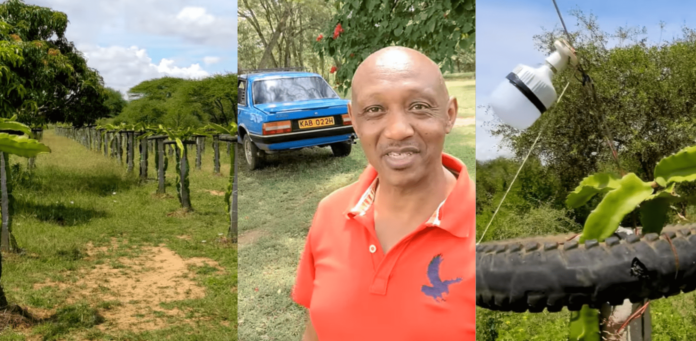As awareness about the Dragon Fruit trade grows among Kenyan farmers, more of them are considering placing theory into practice.
Those who have engaged in the business can attest to the lucrative nature, not only in terms of local and export sales but also in value addition.
Walter Muange is one of the farmers who have cultivated the tropical plant for its fruit. Recognized as the world’s most expensive fruit, growing dragon fruit is a wise investment to the many who are thinking about it.
In an interview with Red Fox TV, Walter Muange showcased his Dragon Fruit orchard at his Machakos homestead, in Masii. He has planted over 200 dragon fruits. The fruits are renowned for their Kiwi-like taste, black seeds and nutritional value.
There are two prevalent varieties in the Kenyan scope; the white-fleshed and red-fleshed type. The yellow-fleshed variety is relatively rarer and predominantly found in countries like Indonesia and Vietnam where large-scale Dragon Fruit farming is practised.
At Muange’s farm, he has planted two stems per post. He has a total of 125 posts in his orchard. Commonly, farmers cultivating Dragon Fruit plant 4 stems on each edge of a cemented pillar.
Muange revealed that during each harvest season; he achieves a minimum yield of 50 fruits from a single pillar.
“One stem should have five healthy branches and one branch can give you hopefully more than five fruits. Each pillar should be able to give you about 50 fruits,” Muange explained.
Muange uses Motorbike tires to construct the support trellis for his Dragon Fruits. He fastens these tires atop the pillars to provide a sturdy support for the branches’ growth.
To maximize yield from each plant, Muange employs a technique called tipping. He prunes the parent stem to encourage the growth of additional branches. By having more branches, Muange’s plants bear more fruits ultimately increasing his overall harvest.
“When one stem comes through, you do what we call tipping so that it produces five more branches. You don’t allow it to overgrow,” he added.
More fruits translate into substantial profits, considering that the plant isn’t labour intensive. In the current market, a single fruit fetches between Sh. 400 and Sh. 600 during the high and low seasons, respectively.
The weight of a single fruit is an added advantage, as three fruits are sufficient to make a kilogram. One kilogram can sell for up to Sh. 1500.
“This is quite good as you know the fruit is retailing at about Sh. 1,500 a kilo; we sell as wholesale at Sh. 400 per piece or on low season Sh. 600,” he clarified.
Contrary to popular imaginations, Dragon Fruit farming is not a rich-quick venture. It demands patience, as well as precise timing and execution.
When grown from seeds, the plant can take up to five years to reach full maturity and start producing fruits. On the other hand, cultivating it from a seedling typically takes around 9-15 months before attaining maturity.
The Dragon fruit bud develops into a flower, taking 13 days, approximately. On the 13th night, the flower opens up for pollination. It has a limited window of pollination and if this is missed, the plant will not bear fruit until the next season.
Once pollinated, it will take around 38 days to ripen and become ready for harvesting. Fortunately, the plant which belongs to the Cacti family, and does not require a lot of water.
Dragon Fruit: How Kenya’s most expensive fruit is making farmers multi-millionaires
Muange uses one litre of water weekly at normal temperatures while when in hot temperature seasons he can use two litres of water. He adds mulch at the bottom to keep the water from vaporating.
Furthermore, he employs clever tactics to maximize the number of harvests he can obtain in a year. One of his strategies involves manipulating the growth of plants, enabling them to produce more rapidly. He uses extra lighting in his farm setup.
The light provides the plants with the necessary energy to stimulate growth and fruiting, enabling them to get multiple harvests in a year.
“Instead of getting two harvest seasons per year, you can harvest it anytime of the year. That’s why I’ve put extra lighting; low energy bulbs,” he stated.









Hello could you get me into contact with him.I always wanted to venture into dragon fruit planting